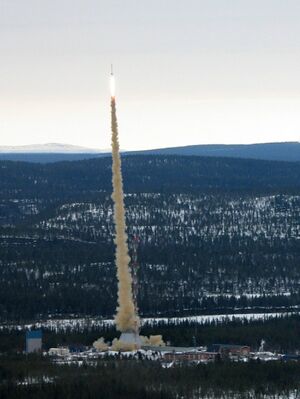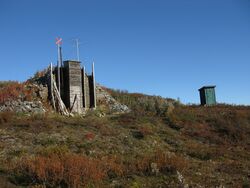إسرنج


مركز إسرنج الفضائي إنگليزية: Esrange Space Center (اختصاراً إسرنج) هو ميناء فضائي ومركز أبحاث يقع على بعد حوالي 40 كيلومتراً شرق بلدة كيرونا في شمال السويد. وهو قاعدة لبحوث علمية بمنطاد بحثي، وللبحث في ظاهرة الشفق القطبي، و عمليات إطلاق صواريخ التجارب، والسواتل، ضمن أشياء أخرى. يقع المركز على بعد 200 كيلومتر شمال الدائرة القطبية الشمالية وتحيط به مساحة برية شاسعة، وموقعهالجغرافي مثالي للعديد من هذه الأغراض.
بُني إسرنج عام 1964 عن طريق ESRO، هيئة أبحاث الفضاء الأوروپية، والتي أصبحت فيما بعد وكالة الفضاء الأوروپية من خلال دمجها مع ELDO، المنظمة الأوروبية لتطوير منصات الإطلاق. تم إطلاق أول صاروخ من إسرنج في 19 نوفمبر 1966.[1] في عام 1972، تم نقل الملكية إلى شركة الفضاء السويدية.
تاريخ
الاسم
أنشطة إطلاق الصواريخ

| Programme | Rocket motor | Peak altitude | Payload mass | Microgravity time | Period | Launches | Customers |
|---|---|---|---|---|---|---|---|
| Texus | Skylark 7, VSB-30 | 250–300 km | 330–400 kg | 6 minutes | 1977– | 57 | DLR and ESA |
| Maser | Black Brant, Skylark 7, VSB-30 | 250–300 km | 330–400 kg | 6 minutes | 1987– | 15 | ESA |
| Maxus | Castor 4B | 700–720 km | 800 kg | 12–13 minutes | 1991– | 8 | ESA and DLR |
| Mini-Texus | Nike Orion | 120–150 km | 160–200 kg | 3–4 minutes | 1993–1998 | 6 | DLR and ESA |
| Rexus | Improved Orion | 80–110 km | 100kg | 2 minutes | 1995– | 28 | DLR, ESA, ZARM |
| MAPHEUS | Nike-Orion, VS-30, Improved Malemute/Improved Malemute | 150-250 km | - | 6 minutes | 2009- | 12 | DLR |
| SERA | Cesaroni Pro 98-6G | 5-10 km | - | - | 2014- | 3 | CNES |
SSC, jointly with DLR, introduced a new launch service with the Suborbital Express programme launched in 2019. Suborbital Express is now integrating the Maser microgravity programme.[2]
More than 500 rockets have been launched from Esrange since 1966. For information on individual rockets, see the List of rockets launched from Esrange.
Esrange has six launchers:
- MAXUS launcher (used for the CASTOR 4B rocket)
- MAN launcher (owned by DLR)
- MRL Launcher (used for the Orion, Nike-Orion, Taurus-Orion, Nike-Black Brant V, Terrier-Black brant rockets)
- Skylark launch tower (used for the VSB 30 rocket)
- FFAR launcher (used for Folding Fin Aircraft Rockets)
- SULO/VIPER launcher (used for Super Loki and VIPER rockets)
Balloon activities
Since 1974, more than 500 high-altitude balloons have been launched from Esrange for research purposes. The launch pad can handle balloons with volumes exceeding 1 million cubic meters.
Satellite services
The arctic latitude of Esrange makes it very suitable for communication with satellites in polar orbits. Esrange Satellite Station is part of a global network with stations in Canada, Alaska, Hawaii, Chile and Australia. This global network is managed from Esrange.
Esrange Space Center satellite station emphasizes on data acquisition and processing for remote sensing and scientific missions as well as TT&C support. The station is often used in combination with SSC's Inuvik Satellite Station in northern Canada, to increase coverage opportunities for polar orbiting missions.
Esrange Space Center satellite station includes six independent Telemetry Tracking & Command (TT&C) systems in S-Band (one with receive capability also in the UHF-Band), six multi-frequency receive antenna systems in S/X-Band and an operational building which houses reception system electronics and data processing equipment. Satellite services at Esrange began in 1978.
Satellite control services
A number of telecommunication satellites have been controlled through Esrange:
Most research satellites of the Swedish space programme have received control commands through Esrange:
The exception was controlled from SSC's laboratories in Solna outside Stockholm:
- Astrid-2 (1998–1999)
Ground station services
Data have been received at Esrange from more than 50 satellites, including SPOT 1–5, Landsat 2–7, ERS-1–2 and Envisat.
Satellite launch capability
Ideas to use Esrange Space Center for orbital launches has existed since the inauguration of the base in 1966, then in the vision of ESRO. As new smaller launcher projects started to emerge in the beginning of the new millennia, SSC started to form new ideas to use these to obtain an orbital capability.
On October 14, 2020, Matilda Ernkrans, the Swedish Space Minister, announced the decision of the Swedish government to establish capability to launch small satellites from Esrange Space Center in northern Sweden.[3]
See also
- List of rockets launched from Esrange
- Swedish Space Corporation
- Swedish National Space Agency
- Swedish Institute of Space Physics
- North European Aerospace Test range
- List of rocket launch sites
- Rexus/Bexus
References
Footnotes
- ^ Jacobsson, Cecilia (6 October 2007). "Rymdturism nästa steg för raketbasen Esrange" [Space tourism next stage for the rocket base Esrange]. Dagens Nyheter (in السويدية). Retrieved 19 March 2016.
- ^ "Suborbital Express". Swedish Space Corporation.
- ^ "SSC to launch satellites from Esrange Space Center". SSC. Retrieved 2020-10-14.
Sources
- The History of Sounding Rockets and Their Contribution to European Space Research, Günther Seibert, ESA HSR-38, November 2006, ISBN 92-9092-550-7.
External links
 Media related to Esrange at Wikimedia Commons
Media related to Esrange at Wikimedia Commons- Esrange Space Center
- List of stratospheric balloons launched from Esrange
- Swedish Space Corporation - Official site
- CS1 السويدية-language sources (sv)
- Pages using gadget WikiMiniAtlas
- Short description is different from Wikidata
- Articles containing إنگليزية-language text
- Pages using Lang-xx templates
- Coordinates on Wikidata
- European Space Agency
- Spaceflight
- Spaceports in Europe
- Rocket launch sites
- Science and technology in Sweden
- Space programme of Sweden
- Kiruna
- Buildings and structures in Norrbotten County
- 1966 establishments in Sweden

